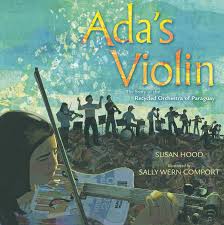
“With her violin, Ada could close her eyes and imagine a different life.”
Ada is a young girl who lives in a slum on a rubbish tip. Everyone in her family and community earn a living by collecting materials to recycle. It is a hard and difficult life.
Ada and many of her friends love music. They sign up for lessons; but, unfortunately it is not safe to keep the expensive instruments in their homes and they need to practice. The community comes together to make instruments from the materials that they find at the rubbish tip. The children are able to practice and they form a ‘recycled’ orchestra.
Ada’s Violin is a story about a community that showed how creative and innovative they could be when faced with a problem to solve. It shows perseverance; and, individual and communal commitment towards a goal.
To find out more about the true story that inspired this book:
http://www.recycledorchestracateura.com/
Recycled Orchestra a Video
Connections:
Learner Profile Attributes: Thinkers (creatively used recycled materials to create instruments), Communicators (used music to express their ideas and communicate with others).
Attitudes: Commitment (Ada showed commitment to learn the violin), confidence (demonstrated confidence in her own ability when performing in front of an audience), cooperation (to be a successful orchestra you have to have a cooperative relationship with members), enthusiasm (regularly practiced to improve her musical abilities), creativity (creatively used materials to make musical instruments out of recycled materials)
PYP Concepts: Connection (e.g. How is music linked to Ada’s self belief?), Causation (e.g. Why do people live in rubbish dumps?) , Form (e.g. What is a slum?), Function (e.g. How does a musical instrument work?), Perspective (How would the audience view Ada’s life differently?)
Links to transdisciplinary themes: How we Express Ourselves , Who We Are, Where We Are In Place and Time, Sharing the planet.

